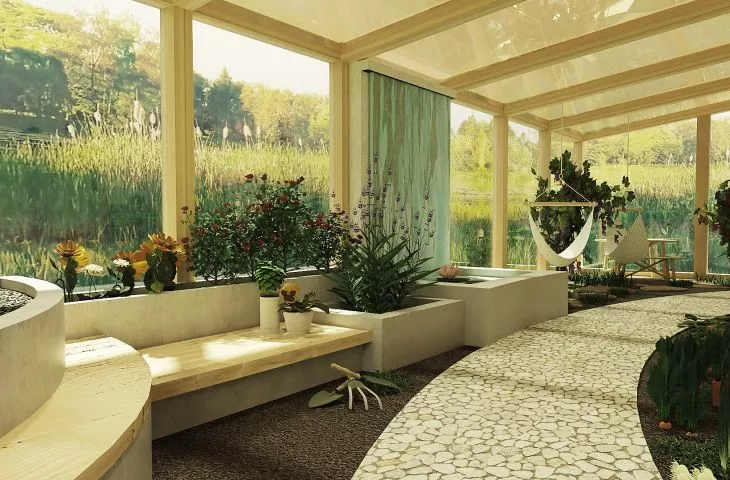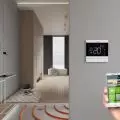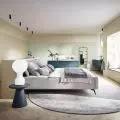4 Description of the project work
location
The location is not specified. Ideally, such a space would be created as an individual building, integrated into a suitable location. Most snoezelen rooms are located in places, i.e. hospitals, various centers, for example. I assume that everyone would have the opportunity to use such a space, conducive to learning something new and different. It is a place largely cut off from the outside world, thanks to adequate soundproofing and the absence of windows. Thus, anyone who finds himself in such an interior would feel as if he were entering another world and would have the opportunity for a "different" way of experiencing, experimenting something hitherto alien, unknown to him.
This would be a certain showcase of snoezelen. I believe that this would maximize the potential of the method and it would reach a larger audience and become more well-known. In my project, however, I present a section of some larger whole, it is a truncated scope, touching on the main assumptions.
functional assumptions, the idea of the project
For an artist, the most important thing is aesthetics - something must look good, be "eye-friendly". Usually this can be combined with functionality, but often the problem arises that something must be given up. Do not forget about the harmonious appearance of the interior, remembering that we do not perceive only with the eyes, but with all the senses. Therefore, in the premise, I decided that the room I designed would be a white room. White is an ideal carrier of colored light. The interior is built on the basis of a variety of solids in shades of white.
The space is to fulfill two most important functions - activation and relaxation. These functions are marked by shades of white - the active zone is in lighter tones, both white and light; the relaxation zone in tones of darker white, gray, ecru and muted light - will allow you to calm down. I designed the hortiterapy orangery in such a way that it activates all the senses. It has been divided into individual zones, in which selected plants are placed.
description of the interior
The whole adopted space assumes the division into zones:
- entrance: lobby - space designed for free movement between the therapy rooms, gives the opportunity to choose from which side we enter the various rooms; ladies' and men's toilets ; checkroom
- snoezelen room (has two entrances-exits, choice of direction, zoning), area: 64 m².
pic: © Marta Slota
individual parts of the room:
riddle zone
- Tubes in the wall with holes containing a variety of tactile objects
- This is where the sense of touch is stimulated
touch panel zone
- In this zone: tactile panels, having a variety of tactile texturescontrasting: velvet, sheet metal, weed, wood, aluminum foil, bubble wrap, fur, pebbles, gel balls, sand, Styrofoam, grass, cotton wool. Panels on Velcro, can be moved to different areas of the Hall
- In this zone we stimulate the sense of touch
ball pool
- This is a "conventional pool", made of soft foam
- Semicircular wall panel with holes for balls
- In this area we stimulate motor skills and the sense of touch
transparent partition
- Plexiglas wall, has blackout elements, attached to magnets on both sides, the form referring to the shape of a tree
- The purpose of the partition is integration with another person, slight darkening, subtle separation of the activation zone from the relaxation zone
- Motor stimulation
relaxation space
- Designed to display images, located on a soft platform, soft upholstery (backrests) of the walls there also: poufs, panniers, hammock,
- Stimulating the sense of sight and relaxation
relaxation and activation space
- There: modular set: 4 square elements - illuminated square table and 3 seats, allowing you to adjust the height of the table
- Stimulating the sense of sight
- In the background - a black board wall on which you can paint with glow-in-the-dark markers
- In this part also: a zone stimulating the sense of smell - a wall with open cabinets - puzzles, in them smells, released when opened
- Provided for 6 cabinets, of different sizes - each is responsible for something different, assigned to it are 3 sample scents (interchangeable):
1. improving mood: basil, tangerine, orange;
2. anxiety relief: cypress, bergamot, neroli;
3. relaxation: fir, lemon balm, tea tree;
4. Stimulation and concentration: jasmine, pine, cinnamon;
5. easier breathing: lavender, mint, rosemary;
6. antiseptic: chamomile, lemon, eucalyptus;
- On the other side -place for the part that stimulates the sense of taste, in the form of a wall-mounted countertop (you can bring a variety of flavorings, since there are no permanent ones)
sound room
- In the shape of an irregular square, replaces the sound chair
- Soft floor throughout, pillows, sheepskins
- Walls soundproofed with acoustic foam, wall foam formed in the shape of a wave - comfortable backrests
- Musical instruments mounted to the walls and ceilings: drums, gongs, cymbals, bells, tambourine, maracas and speakers, hidden in the walls (possible selection of sounds e.g. with the help of an app
- Active zone (production of sounds), but also relaxation (listening to sounds or silence - niche)
- Entrance - a curtain of fiber optics
- Stimulating the sense of hearing, relaxation
space with columns and mirrors
- 3 transparent columns, varying in height and width, with small elements in them, driven by a fan
- The columns make a light hum, comparable to the sound of the wind
- The mirrors are meant to give a sense of depth
- On the other side - a wall with illuminated openings of various sizes, in them illuminated sensory bottles
- Here, too, a bar attached to the ceiling with rotating acrylic mirrors
hortiterapy room
Area: 48 sq. m. The hortiterapy room (like the snoezelen room) has two entrances-exits and zoning:
- A zone of ornamental plants, with a system of modular pots with seating(tentatively located on the northeast side)
- Zone with vegetables and herbs - vegetables and herbs can be planted directly in the ground or in pots mounted to the wall
- Relaxation zone, where there are also fruits and a corner where you can sit - hammocks are hung there (tentatively located on the southeast side).
The zones are located here interchangeably (the modular pots are not permanently built in, which makes it possible to move).
Hortiterapy room
pic: © Marta Slota
A fountain is envisaged in the central part, ensuring adequate humidity in the room and activating the sense of hearing, touch...
lighting
The most important role of lighting in the Room is to mark the zones, the most activating one and the most relaxing one. The main interior lighting is led strips - a system operated by remote control. It has adjustable color and hue saturation (individually adjustable). The led strips also illuminate the doors so that the entrance and exit are clearly visible. Other lighting elements are small neon pictograms, they play the role of communication and serve to mark the different senses that are activated in specific places in the room. Additional lighting of the Room is provided by small light elements. Light in this interior plays a very important role, as it defines the entire character of the Room, which by design is a white room, meaning that it is mainly light that defines it.
The materials and lighting used are certified for fire safety.
Marta SLOTA
The master's diploma was created at the Interior Design Studio of the Cracow Academy of Fine Arts.
Supervisor: Joanna Kubicz, PhD, Professor at the Academy of Fine Arts.
1 A.Smrokowska-Reichmann, Snoezelen - Hall ofExperiencing theWorld, Wrocław 2013, p. 19.
2. https://sjp.pwn.pl/sjp/relaks;2573840.html, accessed November 19, 2019
3. https://sjp.pwn.pl/sjp/aktywizacja;2549299.html, accessed November 19, 2019
4. https://encyklopedia.pwn.pl/haslo/dialog;3892432.html, accessed November 14, 2019
5. A.Smrokowska-Reichmann, Snoezelen - Hall of Experiencing the World, Wroclaw 2013, p.101-102
6.A. Smrokowska-Reichmann, Snoezelen - Hall of Experiencing the World, Wroclaw 2013, p.90-91
7. https://rme.cbr.net.pl/index.php/archiwum-rme/356-wrzesien-pazdziernik-nr-69/wiadomosci-rolnicze/800-hortiterapia-czyli-zbawienny-wplyw-roslin-na-zdrowie-czlowieka, accessed 25.02.2020
8. e.Janus, A.Bac, A.Kulis, A.Smrokowska-Reichmann, Occupational therapy in geriatrics, Warsaw 2017, p.115
9. http://www.jadowniki.caritas.pl/article/hortiterapia, accessed December 30, 2019
10. E.Janus, A.Bac, A.Kulis, A.Smrokowska-Reichmann, Occupational therapy in geriatrics, Warsaw 2017, p.118
11. https://zwierciadlo.pl/parenting/wychowanie-dziecko/snoezelen-nowa-terapia-dla-dzieci-i-doroslych/2, accessed November 20, 2019 .
12.Alain de Botton, The Architecture of Happiness, 2006, p. 104.
13.W.Strzeminski, Theory of Vision,Cracow1974, p. 14.
14.J.Pallasmaa, Eyes of the skin,Krakow2012, p.58.
15.E.T.Hall, Hidden dimension, Warsaw 2001, p. 81.
16. A.Smrokowska-Reichmann, Snoezelen - Hall of Experiencing the World, Wroclaw 2013, p. 118.
17.D.Sudjic, The Language of Things,Cracow2013, p. 79.
18. https://www.socoffee.pl/co-ma-kolor-kubka-do-smaku-kawy/, accessed 7.01.2020.
19. https://fizjo4life.pl/czym-jest-propriocepcja-i-po-co-ja-trenowac/, accessed December 7, 2019.
20. J.Pallasmaa, Eyes of theskin,Krakow2012, p. 26.
21. S.E.Rasmussen, Odczuwanie architektury,Kraków2015, p. 246
22. https://betamed.pl/poradniki/koloroterapia/, accessed December 11, 2019
23. A.Smrokowska-Reichmann, Snoezelen - Hall ofExperiencing theWorld, Wroclaw 2013, p.160-164
24. https://centrumsnoezelen.pl/dzwieki-i-muzyka-w-snoezelen/, accessed March 4, 2020




















































